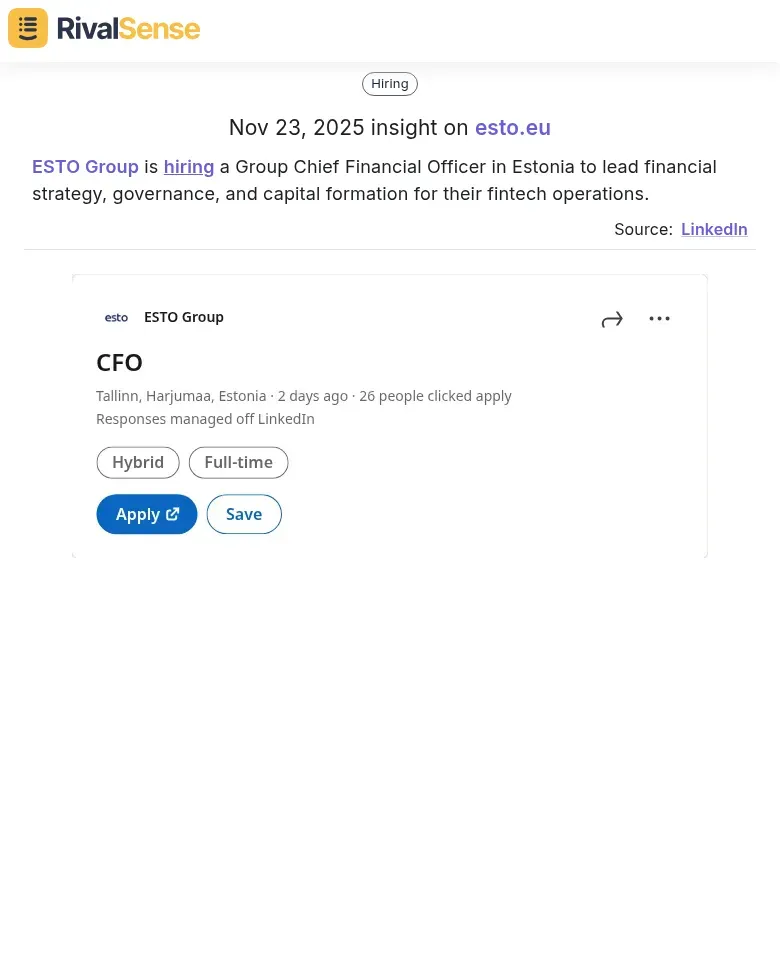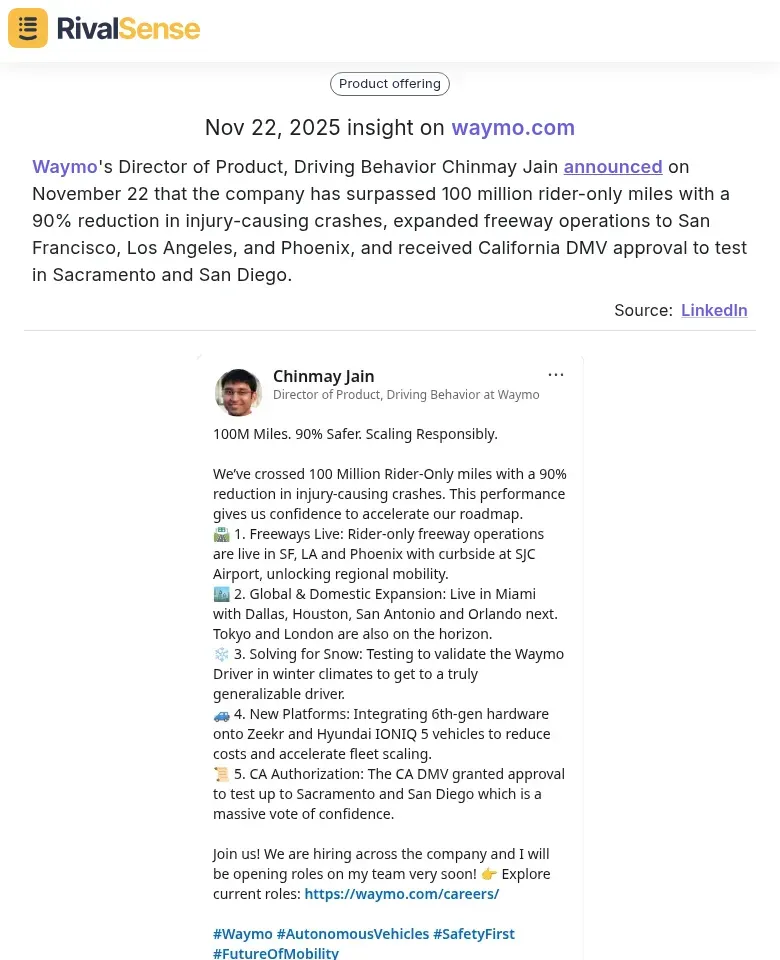The Ultimate Guide to Key Account Tracking Automation in 2025
In today's volatile business landscape, where global market dynamics shift overnight and client priorities change by the minute, manual key account tracking has become a liability. The traditional approach of static slides, outdated org charts, and manual data entry is not just inefficient—it's actively costing you revenue opportunities and putting your most valuable accounts at risk.
Consider this: 68% of B2B companies report losing key accounts due to missed signals and relationship gaps that could have been identified with proper tracking automation. The accounts that generate 80% of your revenue deserve more than spreadsheet-based management.
What Key Account Tracking Automation Actually Solves
Key account tracking automation addresses the core inefficiencies that plague manual methods, transforming how businesses protect and grow their most valuable relationships. By automating intelligence gathering, companies can shift from reactive firefighting to proactive strategic management.
The Core Problems Manual Tracking Creates:
- Stale Intelligence: Account plans become outdated within weeks, sometimes days
- Missed Opportunities: Cross-sell and upsell chances slip through the cracks
- Relationship Blindspots: Key stakeholder changes go unnoticed
- Reactive Management: You're always playing catch-up instead of leading strategy
- Data Silos: Critical information lives in different systems and team members' heads
The Automation Advantage:
Automated tracking transforms key account management from reactive to proactive. Instead of manually hunting for information, you receive curated intelligence that highlights:
- Competitive movements that could threaten your position
- Expansion opportunities based on client growth and changing needs
- Relationship risks from stakeholder departures or organizational changes
- Market shifts that create new service or product opportunities
The Essential Checklist for Key Account Tracking Automation
Selecting the right automation tool is crucial for maximizing the benefits of key account tracking. This checklist will help you identify the features that deliver the most value for your business strategy and implementation needs.
What to Look For in Your Automation Solution:
✅ Real-time Monitoring: Tracks 80+ sources including websites, social media, registries
✅ Competitor Intelligence: Automatically surfaces competitor product launches, pricing changes, partnerships
✅ Relationship Mapping: Identifies organizational changes and new stakeholders
✅ Risk Alerts: Flags potential account threats before they become problems
✅ Opportunity Identification: Uncovers whitespace and expansion possibilities
✅ CRM Integration: Seamlessly connects with your existing sales stack
✅ Weekly Reporting: Delivers curated insights without overwhelming your team
Implementation Steps:
- Audit Your Current Process: Identify where manual tracking creates the biggest gaps
- Define Key Signals: Determine what changes matter most for your key accounts
- Select the Right Tool: Choose a solution that covers your intelligence needs
- Integrate with CRM: Ensure automated insights flow into your existing workflows
- Train Your Team: Focus on actioning insights rather than gathering data
- Measure Impact: Track account growth, retention, and expansion metrics
How RivalSense Transforms Key Account Tracking
RivalSense offers a unique approach to key account tracking by automating external intelligence gathering across multiple data sources. This ensures your account strategies are always informed by the latest market and competitive developments.
Automated Competitive Intelligence
RivalSense tracks competitor movements across 80+ sources, delivering weekly reports that include:
- Product launches and updates
- Pricing strategy changes
- Event participation and speaking engagements
- Partnership announcements
- Regulatory developments
- Management team changes
- Media mentions and coverage
Real-World Insights from RivalSense
Seeing actual examples of automated insights can demonstrate their strategic value for key account management. Here are real RivalSense insights that highlight how timely intelligence can inform your business decisions.
Product Launch Insight: Lumion's New Asset Packs

Lumion released new asset packs in Lumion Cloud for creating festive or cozy scenes.
Why it matters for business strategy: Tracking competitor product launches helps you anticipate client needs and proactively offer solutions, preventing churn and identifying upsell opportunities before competitors gain ground.
Management Change Insight: ESTO Group Hiring CFO

ESTO Group is hiring a Group Chief Financial Officer in Estonia to lead financial strategy, governance, and capital formation for their fintech operations.
Why it matters for business strategy: Monitoring organizational changes allows you to update relationship maps and tailor engagement strategies to new decision-makers, ensuring continuity and strengthening partnerships during transitions.
Regulatory and Expansion Insight: Waymo's Milestones

Waymo's Director of Product, Driving Behavior Chinmay Jain announced on November 22 that the company has surpassed 100 million rider-only miles with a 90% reduction in injury-causing crashes, expanded freeway operations to San Francisco, Los Angeles, and Phoenix, and received California DMV approval to test in Sacramento and San Diego.
Why it matters for business strategy: Keeping tabs on regulatory approvals and market expansions helps you identify new opportunities or threats in your key accounts' industries, enabling proactive strategy adjustments and risk mitigation.
Practical Application for Account Managers
Example Scenario: One of your key accounts in the manufacturing sector suddenly starts engaging with a competitor who just launched a new AI-powered solution. With manual tracking, you might not discover this until your next quarterly review—potentially too late. With RivalSense, you receive an automated alert about the competitor's product launch and can proactively address your client's interest before it becomes a threat.
Integration with Your Existing Stack
RivalSense complements tools like DemandFarm, LinkedIn Sales Navigator, and Gong by providing the external market intelligence these platforms lack. While they help you manage relationships and conversations, RivalSense ensures you understand the competitive context those relationships exist within.
Beyond Basic Automation: The Strategic Advantage
Automating key account tracking goes beyond efficiency gains to deliver significant strategic advantages. It enables businesses to move from reactive account management to proactive partnership building, driven by real-time intelligence.
Proactive vs. Reactive Account Management
Traditional account management waits for clients to bring problems or opportunities. Automated tracking flips this model by:
- Anticipating Needs: Identifying client challenges before they articulate them
- Spotting Trends: Recognizing industry shifts that create new service opportunities
- Preventing Churn: Catching competitive threats early enough to counter them
- Driving Growth: Uncovering expansion opportunities your clients haven't considered
The ROI of Automation
Companies implementing comprehensive key account tracking automation typically see:
- 25-40% reduction in account churn
- 30-50% increase in cross-sell/upsell revenue
- 60-80% reduction in manual research time
- Improved client satisfaction scores through more relevant, timely engagement
Getting Started with Key Account Tracking Automation
Implementing automation doesn't have to be overwhelming if you approach it systematically. Starting with focused initiatives can deliver quick wins and build momentum for broader adoption across your organization.
Quick Wins You Can Implement Today
- Start with Your Top 5 Accounts: Focus automation on your most valuable relationships first
- Define Your Priority Signals: What competitor movements or client changes matter most?
- Establish Alert Thresholds: Determine what level of change warrants immediate attention
- Create Response Protocols: Have pre-planned actions for common scenarios
- Measure and Iterate: Track what intelligence drives the most value and adjust accordingly
Common Pitfalls to Avoid
❌ Information Overload: Too many alerts without prioritization
❌ Tool Sprawl: Multiple disconnected systems that create more work
❌ Analysis Paralysis: Collecting data without clear action plans
❌ Team Resistance: Failing to demonstrate the time-saving benefits
The Future of Key Account Management
As we move into 2026, the gap between companies using advanced tracking automation and those relying on manual methods will widen significantly. The ability to automatically monitor competitive landscapes and client ecosystem changes will become essential for effective account management.
Tools like RivalSense represent the next evolution—moving beyond internal relationship management to comprehensive market intelligence automation. The most successful account managers won't just be relationship experts; they'll be intelligence-driven strategists who can anticipate client needs and competitive threats before they materialize.
Ready to Transform Your Key Account Strategy?
The transition from manual tracking to automated intelligence gathering fundamentally changes how you protect and grow your most valuable accounts. By implementing the right tools, you can shift from reactive account management to proactive strategic partnership.
Ready to see the difference? Try out RivalSense for free at https://rivalsense.co/ to get your first competitor report today and start automating your key account tracking with actionable insights delivered weekly.
📚 Read more
👉 How to Track Competitor Funding for Supply Chain Optimization
👉 How Vanta's Middle East Move Spurred Competitor Action
👉 How Website Changes Reveal Competitor Strategies for Key Accounts
👉 Key Account Engagement Checklist for Roofing CRM Success
👉 Product Offering Competitor Analysis: Template & Framework
